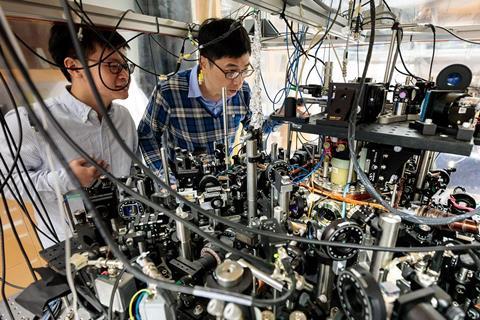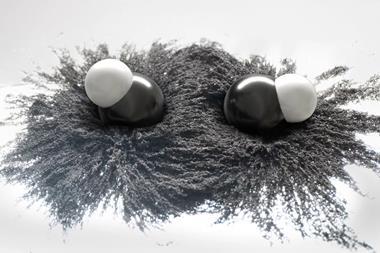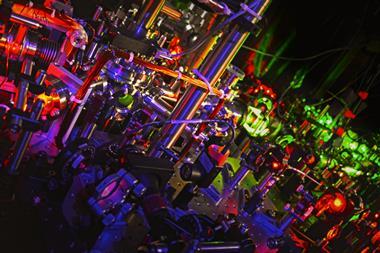US researchers have observed a phenomenon known as ‘quantum superchemistry,’ in which ultracold atoms undergo chemical reactions at a faster rate than usual. The effect was predicted theoretically more than 20 years ago, but this is one of the first times the phenomenon been seen.
One of the main reasons that superchemistry – in which numerous atoms act collectively – has proven so difficult to observe is the need to cool the experiments to near absolute zero, says University of Chicago physicist Cheng Chin.
‘At the moment we have to get to a temperature of about 10nK,’ he says. ‘But our understanding is that if we have more particles, then this condition can be relaxed.’
Chin and his colleagues supercooled a gas of caesium atoms until they combined to form a Bose–Einstein condensate, or BEC, where the atoms collectively act as if they have a single quantum state. The researchers then applied a magnetic field to the BEC, to stimulate a chemical reaction in which caesium atoms partner up to form caesium molecules.
In classical chemistry, the caesium atoms in a gas would bounce around until two collided with each other, with a chance that they would then form a caesium molecule with the formula Cs2. All such reactions within the gas at the largest scale would take place over a period of time, with some atoms colliding and forming molecules early on and some doing so later, depending on the concentration of atoms.
But in the latest experiment, the supercooled caesium atoms within the BEC formed caesium molecules all at once, at a significantly faster rate than when the reaction takes place under classical conditions.1 For example, in an experiment with a few thousand atoms, the increase in the reaction rate was on the order of three to five, Chin says. And the research shows that more atoms there are in the BEC, the faster the reaction occurs.
‘You are no longer treating a chemical reaction as a collision between independent particles, but as a collective process,’ he told the University of Chicago’s website. ‘All of them are reacting together, as a whole.’

The phenomenon is counter to another observed effect of BECs, in which chemical reactions between ‘fermionic’ atoms are supressed in such a state.2 The total number of constituent particles in ‘fermionic’ atoms is always an odd number, while the total number of particles in caesium and other ‘bosonic’ atoms is an even number, explains physicist Peter Krüger of the University of Sussex, who was not involved in the research. ‘ Here, with bosons, you get an enhancement of thermodynamics,’ he says. ‘It’s really interesting from a fundamental point of view – a new class of phenomenon.’
Physicist Wolfgang Ketterle from the Massachusetts Institute of Technology, who was also not involved in the project notes it may not be the first observation of quantum superchemistry, citing a paper from 2000 that reported evidence of it.3
‘But the new paper is different and goes far beyond previous studies,’ adds Ketterle, who shared the 2001 physics Nobel prize for his pioneering work on BECs.
Another of the Chicago team’s observations is that the individual caesium atoms can be ‘primed’ so the resulting caesium molecules all have the same molecular state, with specific physical and chemical properties. Chin says his team has more work to do on this – but whereas such molecular states are random in classical chemistry, it seems they can be selected in quantum superchemistry.
‘That’s why I’m excited about this work,’ Chin says. ‘Not only can we see a faster reaction, but also [the products are formed in] a particular molecular state.’ Future studies will focus on these molecular states, and on expanding the range of substances to more complex molecules, he adds.
While quantum superchemistry might someday have applications in fields like quantum computing, Chin notes that the setup for such experiments is far too complicated to be of practical use. ‘At the moment this is on the fundamental research level,’ he says.
References
1 Z Zhang et al, Nat. Phys., 2023, DOI: 10.1038/s41567-023-02139-8
2 L De Marco et al, Science, 2019, 363, 853–856 (DOI: 10.1126/science.aau7230)
3 D J Heinzen et al, Phys. Rev. Lett., 84, 22, 5029–5033 (DOI: 10.1103/PhysRevLett.84.5029)












No comments yet